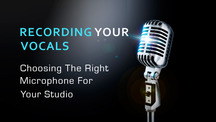The microphone is one of the most important pieces of gear in any studio; and any professional studio will have a large selection of different microphones, each suited to a particular task. But what should you do if you can only afford one? This short post should help you make an informed decision when purchasing a microphone for your home studio.
Microphone Types
Broadly speaking, the two primary types of microphone are dynamic and capacitor – dynamic microphones are well suited to live performance and can operate without ‘phantom power’, whereas other types of microphone need some sort of extra amplification.
In the home studio, condenser microphones are generally favoured, as they tend to be far more sensitive than dynamic mics. Of course, there are plenty of dynamic mics used in studios too – the Shure SM57 and SM58 are practically ubiquitous – and are excellent at dealing with high SPL levels when recording loud instruments such as drum kits. But if you really can only afford one microphone for your studio, then a large-diaphragm condenser would probably be the way to go.
Tubes and Ribbons
Tube microphones come with their own tube-based power supply, which you plug your microphone into using a proprietary cable, and from there into your DAW with a standard XLR. Ribbon mics are also useful in some circumstances, but they are notoriously delicate… they can be destroyed simply by blowing into them, so vocalists need to be kept back a bit.
Pick Up Patterns
Another detail to consider is that of pickup patterns – this determines the directionality of the microphone. An omni pattern means that the mic is sensitive to sound coming from all directions, which is probably not ideal for a small studio.
When recording a solo vocal or instrument, it’s usually best to use the cardioid pattern, which favours the front of the mic, and picks up very little from the rear. Many mics have pattern switches, so you can change according to the task at hand.
Quick Mic Choice
There’s a lot to learn about microphones, and it takes years of experience to know what mic works best for a given situation, for vocals, for guitar, for drums, for outdoor sitar recitals, for voiceovers… the list goes on.
But if you just want to get a decent mic without too much fuss and endless research, the following models have received good reviews from a lot of producers. Everyone has their likes and dislikes, but you won’t go far wrong with any of these (prices for rough reference – pick the one that suits your budget and go find it!).
Tube Microphones
Rode NTK – €466
Neumann TLM – €566
M-Audio Sputnik – €449
Studio Projects T3 – €579
MXL V69M – €265
Studio Projects TB1 – €314
SE Electronics 2200T – €295
Condenser Microphones
M-Audio Nova – €77
Audio Technica AT2020 – €99
M-Audio Luna – €159
Rode NT3 – €159 – battery powered option!
Rode NT1A – €187
MXL V89 – €531
Dynamic Microphones
Shure SM57 – €109 – instruments
Shure SM58 – €109 – vocals
Matched Pair Microphones
M-Audio Pulsar II – €249
Samson C02 – €98
Neumann K184 – €1133
Rode NT5 – €298
Beyerdynamic MCE530 – €185












